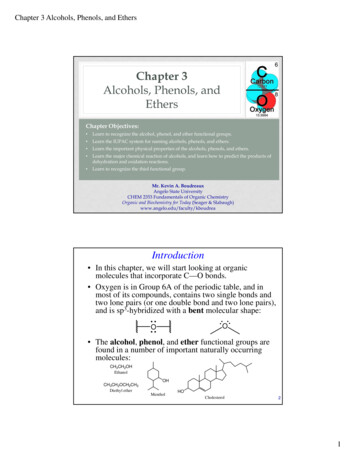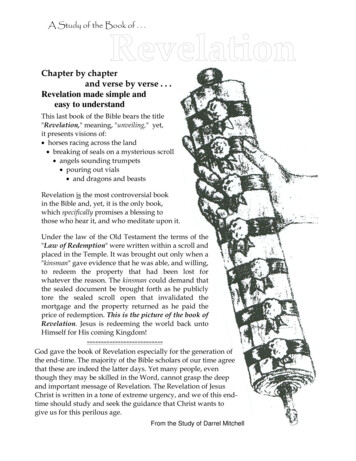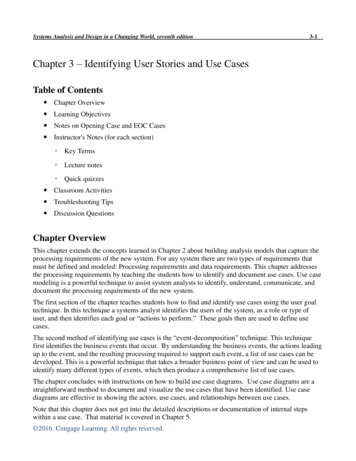
Transcription
Chapter 3 Alcohols, Phenols, and EthersChapter 3Alcohols, Phenols, andEthersChapter Objectives: Learn to recognize the alcohol, phenol, and ether functional groups. Learn the IUPAC system for naming alcohols, phenols, and ethers. Learn the important physical properties of the alcohols, phenols, and ethers. Learn the major chemical reaction of alcohols, and learn how to predict the products ofdehydration and oxidation reactions. Learn to recognize the thiol functional group.Mr. Kevin A. BoudreauxAngelo State UniversityCHEM 2353 Fundamentals of Organic ChemistryOrganic and Biochemistry for Today (Seager & on In this chapter, we will start looking at organicmolecules that incorporate C—O bonds. Oxygen is in Group 6A of the periodic table, and inmost of its compounds, contains two single bonds andtwo lone pairs (or one double bond and two lone pairs),and is sp3-hybridized with a bent molecular shape:OO The alcohol, phenol, and ether functional groups arefound in a number of important naturally iethyl etherMentholHOCholesterol21
Chapter 3 Alcohols, Phenols, and EthersAlcohols3The Hydroxy (—OH) Functional Group The hydroxyl group (—OH) is found in the alcoholand phenol functional groups. (Note: that’s not thesame as hydroxide, OH-, which is ionic.)– in alcohols, a hydroxyl group is connected to acarbon atom.– in phenols, —OH is connected to a benzene ring.(The “parent” molecule of this class is also namedphenol: PhOH or C6H5OH.) When two carbon groups are connected by singlebonds to an oxygen, this is classified as the etherfunctional group.ROHOHan alcoholROR'an ethera phenol42
Chapter 3 Alcohols, Phenols, and EthersWhere Does the Word “Alcohol” Come From? The word “alcohol” comes from the Arabic term alkohl meaning “the fine powder.” Originally, thisreferred to an antimony sulfide (Sb2S3)compoundused for eye shadow, which was ground up to form afine powder, but then later came to refer to anyfinely divided powder. In the Middle Ages, thisterm came to mean the “essence” of anything. When the Europeans took up alchemy in the MiddleAges, they referred to vapors from evaporating orboiling compounds as “spirits,” since they did notbelieve them to be material in the same sense thatsolids and liquids were. Alchemists began referringto “spirits of wine,” and since an alcohol when itboils away seems to powder away to nothing, theyalso began to refer to “alcohol of wine” and thensimply “alcohol”.5Some Common AlcoholsCH3OHCH3CH2OHmethanolmethyl alcohol(wood alcohol)("methy" wine, "hule" wood)Found in wood smoke; contributes to thebouqet of new wine; metabolized in the bodyto formaldehyde and formic acid, and cancause blindness or death ( 50 mL)ethanolethyl alcohol(grain alcohol)The acohol of alcoholic beverages; thefermentation of honey, grain, or fruit juices toyield beers and wines was probably the firstchemical reaction to be discovered; metabolizedin the body to produce acetaldehydeCH3CH2CH2OHOH1-propanoln-propyl alcoholCH3CHCH32-propanolisopropyl alcoholRubbing alcohol is 70%isopropyl alcohol and 30% water63
Chapter 3 Alcohols, Phenols, and EthersNomenclature of Alcohols and Phenols Step 1. Name the longest chain to which thehydroxyl (—OH) group is attached. The name forthis chain is obtained by dropping the final -e fromthe name of the hydrocarbon parent name andadding the ending -ol. Step 2. Number the longest chain to give the lowestpossible number to the carbon bearing the hydroxylgroup. Step 3. Locate the position of the hydroxyl groupby the number of the C to which it is attached. Step 4. Locate and name any other substituents. Step 5. Combine the name and location for othergroups, the hydroxyl group location, and the longestchain into the final name.7Examples: Naming Alcohols and Phenols Provide acceptable IUPAC names for the followingcompounds:CH3 OHCH3CH2OHOHCH3CHCH3CH2CH2CH3CH2 OHOHCH3CH3CH84
Chapter 3 Alcohols, Phenols, and EthersExamples: Naming Alcohols and Phenols Provide acceptable IUPAC names for the followingcompounds:CH3 CH2 CH2 CH2 CH2 OHCH3 CH2 CH CH2 CH3OHCH3CH3 CH2 CH CH CH2 OHCH3 CH2 CH2 CH CH2 CH3CH2 OHCH39Examples: Naming Alcohols and Phenols Provide acceptable IUPAC names for the followingcompounds:OHOHOHCH2CHCH3105
Chapter 3 Alcohols, Phenols, and EthersExamples: Naming Alcohols and Phenols Draw and name all of the possible isomers ofbutanol (C4H10O)11Nomenclature of Alcohols and Phenols If there is more than one OH group, a countingprefix (di-, tri-, tetra-, etc.) is placed immediately infront of the suffix -ol (diol, triol, tetraol, etc.).– Usually, the final “e” of the parent hydrocarbon isnot dropped (e.g., 1,2-propanediol).– The position of each alcohol group is indicated bycarbon number, separated by commas (e.g., 1,3butanediol). For cyclic alcohols, the carbon bearing the OH isnumbered as “1.” Phenols are named after the parent compoundphenol; the C bearing the OH is numbered as “1.”126
Chapter 3 Alcohols, Phenols, and EthersExamples: Naming Alcohols and Phenols Provide acceptable IUPAC names for the followingcompounds:OHCH2 CH2 OHHOHO CH CH2 CH CH : Naming Alcohols and Phenols Provide acceptable IUPAC names for the followingcompounds:OHCH3OHOHOHClCH2CH2CH3147
Chapter 3 Alcohols, Phenols, and EthersExamples: Nomenclature of Alcohols Draw structural formulas for the following molecules:– 3-methyl-2-pentanol– 2,4,4,5-tetramethyl-2-heptanol– 1-ethyl-1-hexanol(what’s wrong with this name?)15Examples: Nomenclature of Alcohols Draw structural formulas for the following molecules:– 3-ethylcyclopentanol– 3-ethylphenol– 3-methyl-2,4-pentanediol168
Chapter 3 Alcohols, Phenols, and EthersClassification of Alcohols Alcohols are classified as primary (1 ), secondary(2 ), or tertiary (3 ) according to how many carbongroups are attached to the carbon bearing the OHgroup:HRCHOHHPrimary1 RCR''OHR'Secondary2 RCOHR'Tertiary3 The number of hydrogens on the carbon bearing theOH group does affect some chemical properties.17Physical Propertiesof Alcohols189
Chapter 3 Alcohols, Phenols, and EthersHydrogen Bonding The oxygen-hydrogen bond is an especially polarbond because oxygen is much more electronegativethan hydrogen is.H O-OOH HHHHOHHHOHOHH The O—H bond is therefore a polar bond, and anymolecule which contains an O—H bond (like analcohol) is a polar molecule.19Physical Properties of Alcohols The general rule in solubility is “like dissolves like.” Since the OH group makes alcohols polar, they willmix with polar solvents like water — as long as thecarbon chain is fairly short.– The longer the carbon chain, the less soluble thealcohol is.SolubleShort chainalcoholsmethanolethanolisopropanolWater solubilitybutanolpentanolInsolubleLong chainalcoholshexanolheptanoletc.2010
Chapter 3 Alcohols, Phenols, and EthersHydrogen Bonding of Alcohols Alcohols hydrogen-bond to water:ROHOHROHHROHOHH Alcohols also hydrogen-bond to each other:ROOHROHHHROROHR21Boiling Points of Alcohols Because alcohols hydrogen bond to each other, theyhave higher boiling points than alkanes of the samemolecular weight. The boiling point of alcohols increases as themolecules become larger.NamepropaneStructureCH3CH2CH3dimethyl ether CH3OCH3ethanolCH3CH2OHMolecular BoilingWeightPoint44.09 g/mol -42.1 C46.07 g/mol -24 C46.07 g/mol 78.3 C2211
Chapter 3 Alcohols, Phenols, and EthersExamples: Physical Properties of Alcohols Arrange the following substances in order ofincreasing boiling point and increasing solubility inwater:– 2-butanol– 2-propanol– 2-methylpropane– 2-pentanol232412
Chapter 3 Alcohols, Phenols, and EthersReactions ofAlcohols25Dehydration of Alcohols to Produce Alkenes Heating alcohols in concentrated sulfuric acid(H2SO4) at 180 C removes the OH group and a Hfrom an adjacent carbon to produce an alkene, withwater as a by-product. Since water is “removed”from the alcohol, this reaction is known as adehydration reaction (or an elimination reaction):RRRCCHOHCH3 CHOHCH3RRH2SO4180 CCRH2SO4180 CR H2OCRCH3 CH CH2 H2O2613
Chapter 3 Alcohols, Phenols, and EthersDehydration of Alcohols to Produce Alkenes If there is more than one possible product of adehydration reaction, the major product can bepredicted from Zaitsev’s Rule: Zaitsev’s Rule — when an alkene is produced in anelimination reaction, the major product is the onewith the more highly substituted double bond.CH3 CH2CHCH3 H2SO4180 CCH3 CHCH CH3 H2O90%OHCH3 CH2CH CH210%CH3 CH2 CH CH2 CH3H2SO4180 COH27Examples: Dehydration of Alcohols Complete the following reactions:CH3CH3 CH CH CH2 CH3H2SO4180 COHCH3 CH3CH3 CCHCH3H2SO4180 COH2814
Chapter 3 Alcohols, Phenols, and EthersExamples: Dehydration of Alcohols Complete the following reactions:CH3OHH2SO4180 CCH3 CH3OHCH3H2SO4180 CCH329Dehydration of Alcohols to Produce Ethers Heating alcohols (R—OH) in concentrated sulfuricacid (H2SO4) at 140 C removes a molecule of waterfrom two alcohol molecules, causing the two “R”groups to become attached to an oxygen atom,forming an ether functional group:ROH ROHH2SO4140 CCH3CH2OH CH3CH2OHH2SO4140 CROR H2OCH3CH2OCH2CH3diethyl ether3015
Chapter 3 Alcohols, Phenols, and EthersExamples: Dehydration of Alcohols Complete the following reactions:CH3CH2CH2OHCH3CHCH3H2SO4140 CH2SO4140 COHCH3CHCH2CH3H2SO4180 COH31Oxidation of Alcohols to Carbonyl Compounds An oxidation reaction occurs when a molecule loseselectrons. This is usually manifested as an increasein the number of oxygen atoms or a decrease in thenumber of hydrogen atoms. Some common oxidizing agents include potassiumpermanganate (KMnO4), chromic acid (H2CrO4),sodium dichromate (Na2Cr2O7), and other Cr6 salts. Alcohols can be oxidized by removing two H atomsfrom the molecule; the exact products of the reactionwill depend on the type of alcohol. Representation in book:R2CHOH (O) R2C O H2O [O] oxidation3216
Chapter 3 Alcohols, Phenols, and EthersOxidation of Alcohols to Carbonyl Compounds Primary or secondary alcohols can be oxidized toproduce compounds containing the carbonyl group(a carbon-oxygen double bond, C O):ROHCHO[O]CRHRaldehydeorketone1 or 2 alcoholOcarbonyl groupC33Oxidation of 1 Alcohols Primary alcohols are oxidized first to aldehydes, butthe aldehydes are then usually oxidized intocarboxylic acids.ROHCHO[O]O[O]CRHHCRaldehydeOHcarboxylic acid1 COHacetic acidIn the body, oxidation of ethanol to acetaldehyde takesplace in the liver; the acetaldehyde is further oxidized toacetyl coenzyme A, which can be used to synthesize fat oreventually be oxidized to water and carbon dioxide.3417
Chapter 3 Alcohols, Phenols, and EthersOxidation of 2 Alcohols Secondary alcohols are oxidized to ketones, whichcannot be oxidized any further:ROHCR'O[O]CRHR'ketone2 alcoholOHCH3OCH CH3[O]CH3CCH3acetone2-propanol35Oxidation of 3 Alcohols Tertiary alcohols, because there is by definition nohydrogen on the alcoholic carbon, cannot beoxidized:OHRC[O]R''no reactionR'3 alcoholOHCH3CCH3[O]NRCH3t-butyl alcohol3618
Chapter 3 Alcohols, Phenols, and EthersExamples: Oxidation of Alcohols Complete the following reactions:OH[O]CH3OH[O]37Examples: Oxidation of Alcohols Complete the following reactions:CH2OH[O]OHOHCH2OH[O][O]3819
Chapter 3 Alcohols, Phenols, and EthersExamples: Multistep Reactions Often, transformations on organic molecules musttake place in more than one step.OOHOHCH3 CH2 CH2CH2CH3 CH CH3CH2CH3CH2OCH2CH339Total Synthesis of CyclooctatetraeneR. Wilstatter and E. Waser, Ber.,1911, 44, 3423A. C. Cope and C. G. Overberger,J. Amer. Chem. Soc., 1947, 69, 976;1948, 70, 1433HOOCH3OH CH3NH2 ONOdoubleMannichreactionNCH3NaEtOH HOpseudopelletierineOOHOOHH2SO4NCH3NCH31) CH3I2) Ag2ON(CH3)2OH- (CH3)3N OH-(CH3)2N 1) CH3I2) Ag2OBr(CH3)2NNH(CH3)2Br1) CH3I2) Ag2ON(CH3)2Br2(CH3)3NOH- OHN(CH3)3Cyclooctatetraene4020
Chapter 3 Alcohols, Phenols, and EthersSome ImportantAlcohols41Some Important AlcoholsCH2CH2CH2CHOHOHOHOHEthylene glycolantifreeze — pure ethylene glycol freezes at 11 F,but a 50:50 mixture of ethylene glycol and waterfreezes at -37 F; airplane de-icer; humectant (keepsother substances moist), used in ball point pen inksCH3Propylene glycolantifreeze, moisturizerin lotions and foodsOOHOHCinnamic alcoholused in perfumes,particularly in lilac and otherfloral scents; flavoring agent,soaps, cosmeticsOHLactic acidproduced from fermentation ofsugars during anaerobicconditions; sour taste, found insourdough bread, pickles,sauerkraut, sweat, etc.4221
Chapter 3 Alcohols, Phenols, and EthersOHOHOHMentholoil of mint; has a coolingtaste; found in coughdrops, shaving lotion,and mentholated tobacco -Turpineolpine oil; perfume andbactericide used indomestic cleanersBenzyl alcoholused in perfumes and flavors,cosmetics, ointments, ballpoint pen inksOHVitamin AretinolHO43RCO2OHO2CRO2CROHGlycerol / glycerinsoftening agent and moisturizerfound is cosmetics and many foods;used to keep toothpaste moistH OHA triglyceridefats and oilsCHOHOHOHOOHHHOHHHHOHHOHHOH -D-glucoseOHCH2OH4422
Chapter 3 Alcohols, Phenols, and EthersA Few SugarsOHOHOHOOHOHOHOHOOOHOHOHOH -D-ribose -D-fructoseOH -D-deoxyriboseOHOOHHOHOO HO -D-glucoseOHOSucrose(a disaccharide)OHOH -D-fructose45OHOPolyoxyethylenea nonionic detergent; producesless foam, and is more effectiveat lower temperatures than manyother detergentsH2NHOCCCH2OHAmino Acids containing alcoholsH2NOHTyrosine (Tyr)HOCCCH3 CH OHThreonine (Thr)OHH2 NHOCCOHCH2OHSerine (Ser)4623
Chapter 3 Alcohols, Phenols, and EthersPhenols47Characteristics and Uses of Phenols Phenols are usually weak acids:OHO H2O H3O A solution of phenol in water (carbolic acid) can beused as an antiseptic and disinfectant. Joseph Listerintroduced the use of phenol as a hospital antisepticin 1867, which cut down drastically on dea
9 17 Classification of Alcohols Alcohols are classified as primary (1 ), secondary (2 ), or tertiary (3 ) according to how many carbon groups are attached to the carbon bearing the OH group: The number of hydrogens on the carbon bearing the OH group does affect some chemical properties. ROHC H H ROHC H R' ROHC R'' R' Primary 1 Tertiary 3 Secondary 2 18File Size: 387KBPage Count: 37











